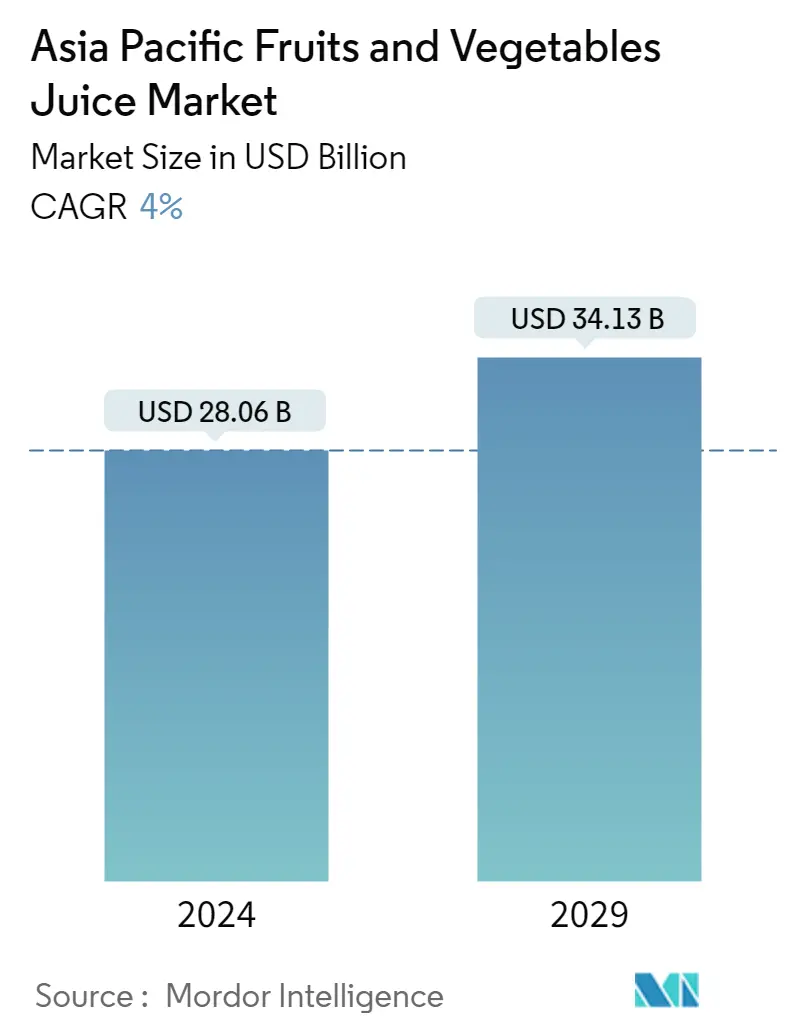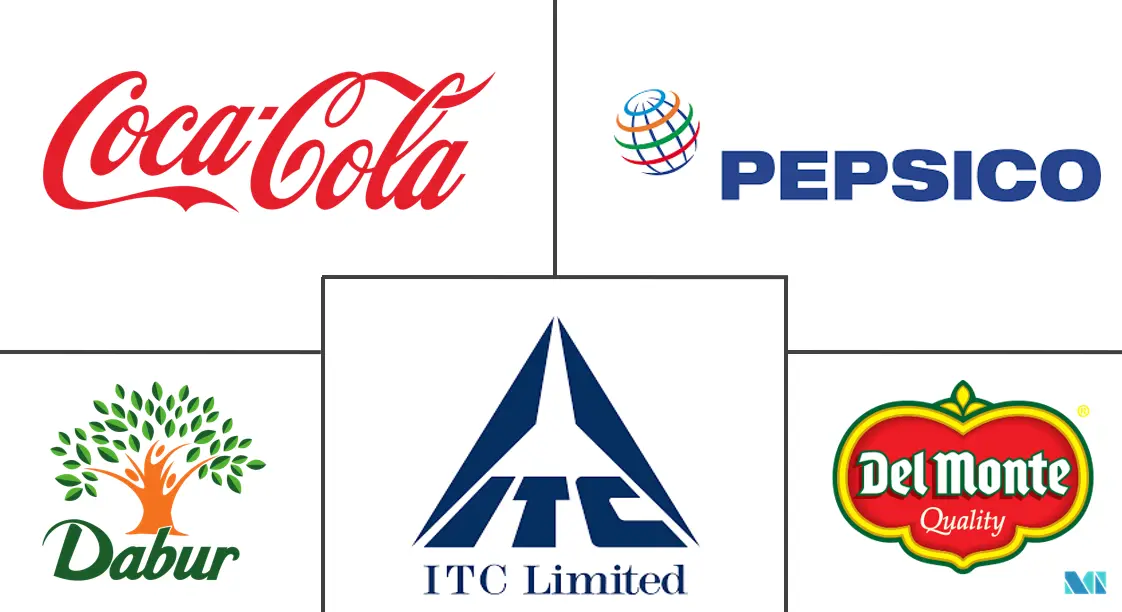Market Size of Asia Pacific Fruits and Vegetables Juice Industry

| Study Period | 2019 - 2029 |
| Base Year For Estimation | 2023 |
| Market Size (2024) | USD 28.06 Billion |
| Market Size (2029) | USD 34.13 Billion |
| CAGR (2024 - 2029) | 4.00 % |
| Market Concentration | Low |
Major Players
*Disclaimer: Major Players sorted in no particular order |
APAC Fruits and Vegetables Juice Market Analysis
The Asia Pacific Fruits and Vegetables Juice Market size is estimated at USD 28.06 billion in 2024, and is expected to reach USD 34.13 billion by 2029, growing at a CAGR of 4% during the forecast period (2024-2029).
In the Asia-Pacific region, the growth in the fruit and vegetable juice market is driven by heightened demand for healthy food from an increasingly health-conscious consumer base. To meet this consumer requirement, key players are focusing on introducing different varieties and flavors, along with innovative packaging and product development. In addition, the advancing retail sector in the region has increased the accessibility of consumers to a wide range of products being introduced in the market, which is supplementing the growth rate. However, supermarkets and hypermarkets lead the contributing share among other sales channels in the region.
Additionally, shifting consumer tastes for products with less or no sugar is pushing beverage makers to develop new products according to the consumers' demands. Since customers are actively striving to avoid consuming sugary drinks to minimize the negative consequences of excessive sugar intake, these firms are developing a variety of unique items to meet the accelerating demand for such products. For example, in 2021, Dole Sunshine India introduced natural pineapple juice. The product was claimed to be all-natural with no added sugar or artificial preservatives.
APAC Fruits and Vegetables Juice Industry Segmentation
The juice considered in our study scope includes beverages produced by pressing or extracting the natural liquid found in fruits and vegetables.
The Asia-Pacific Fruits and Vegetables Juice Market is segmented by Category (Fruit and Vegetable), Type (Nectar, Still Juice Drinks, and 100% Juice), Distribution Channel (Supermarkets/Hypermarkets, Convenience Stores, Speciality Stores, Online Retail Stores, and Other Distribution Channels), and Geography (China, Japan, Australia, India, and Rest of Asia-Pacific). The report offers market size and values in (USD Million) during the forecast years for the above segments.
| Category | |
| Fruit | |
| Vegetable |
| Type | |
| Nectar | |
| Still Juice Drinks | |
| 100% Juice |
| Distribution Channel | |
| Supermarkets/Hypermarkets | |
| Convenience Stores | |
| Speciality Stores | |
| Online Retail Stores | |
| Other Distribution Channels |
| Geography | |
| China | |
| Japan | |
| India | |
| Australia | |
| Rest of Asia-Pacific |
Asia Pacific Fruits and Vegetables Juice Market Size Summary
The Asia Pacific fruits and vegetables juice market is experiencing significant growth, driven by an increasing demand for healthy and natural food options among consumers. This trend is largely attributed to a growing health-conscious population that is seeking products with less or no sugar and free from artificial ingredients. Key industry players are responding by introducing a variety of innovative flavors and packaging solutions to cater to these preferences. The expanding retail sector in the region is further enhancing product accessibility, with supermarkets and hypermarkets leading the distribution channels. This shift in consumer preferences towards natural and organic products is propelling the demand for organic juices, as consumers become more aware of the negative impacts of synthetic ingredients in packaged beverages.
China is emerging as a dominant force in the market, benefiting from its vast agricultural production and high purchasing power, which allows for competitive pricing and increased juice consumption. The country's role as a leading exporter of juice products further bolsters its market position. Major companies such as PepsiCo, The Coca-Cola Company, Del Monte Foods, Dabur India Ltd, and ITC Limited are actively expanding their product offerings and distribution networks to capture a larger market share. Innovations like eco-friendly packaging and trendy designs are being employed to differentiate products and gain a competitive edge. Recent developments, such as Tetra Pak's introduction of the Tetra Stelo Aseptic Package in India and Dabur's investment in expanding production capacity, highlight the ongoing efforts to meet the evolving consumer demands in the region.
Asia Pacific Fruits and Vegetables Juice Market Size - Table of Contents
-
1. MARKET DYNAMICS
-
1.1 Market Drivers
-
1.2 Market Restraints
-
1.3 Porter's Five Forces Analysis
-
1.3.1 Threat of New Entrants
-
1.3.2 Bargaining Power of Buyers/Consumers
-
1.3.3 Bargaining Power of Suppliers
-
1.3.4 Threat of Substitute Products
-
1.3.5 Intensity of Competitive Rivalry
-
-
-
2. MARKET SEGMENTATION
-
2.1 Category
-
2.1.1 Fruit
-
2.1.2 Vegetable
-
-
2.2 Type
-
2.2.1 Nectar
-
2.2.2 Still Juice Drinks
-
2.2.3 100% Juice
-
-
2.3 Distribution Channel
-
2.3.1 Supermarkets/Hypermarkets
-
2.3.2 Convenience Stores
-
2.3.3 Speciality Stores
-
2.3.4 Online Retail Stores
-
2.3.5 Other Distribution Channels
-
-
2.4 Geography
-
2.4.1 China
-
2.4.2 Japan
-
2.4.3 India
-
2.4.4 Australia
-
2.4.5 Rest of Asia-Pacific
-
-
Asia Pacific Fruits and Vegetables Juice Market Size FAQs
How big is the Asia Pacific Fruits and Vegetables Juice Market?
The Asia Pacific Fruits and Vegetables Juice Market size is expected to reach USD 28.06 billion in 2024 and grow at a CAGR of 4% to reach USD 34.13 billion by 2029.
What is the current Asia Pacific Fruits and Vegetables Juice Market size?
In 2024, the Asia Pacific Fruits and Vegetables Juice Market size is expected to reach USD 28.06 billion.

